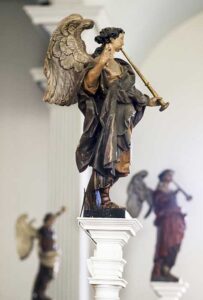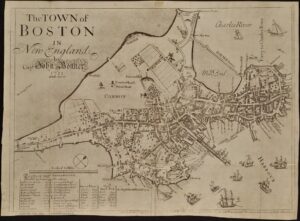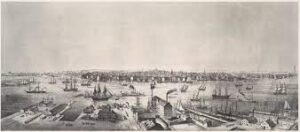Wooden Walls and Waterborne Wealth
By Bernard Trubowitz
New England’s history and development is inextricably tied to the sea, and by no accident. The ocean provides many things to a nation, be it food, cheap bulk transportation, or protection from overland invasion. The seas teemed with such abundance that “Neptune’s larder” seemed inexhaustible. (Despite heavy overfishing and damage by pollution, oceans and lakes are still a major source of food for the world today). For most of human history, prior to the development of railroads, trucks (let alone paved roads), or aircraft, the well-known efficiencies of water transportation made seas and rivers vital highways in national and global trade and drove generations of explorers to search for water passages across continents or the arctic.
Adam Smith’s seminal 1776 “An Inquiry into the Nature and Causes of the Wealth of Nations” spends a great deal of time examining the economics of waterborne transport versus land (flat, usually smooth, and low friction, water is still the preferred long-distance global bulk transport medium). He also studied the history of civilization up to that point and how proximity to navigable seas, rivers, and later canals spurred the growth of nations from antiquity, while also noting that control over these waterways was equally important from an economic perspective. The military and defensive perspective was equally well articulated, with naval theory clearly summed up by statements such as those of Thomas Augustine Arne, who declared “Britain’s best bulwarks are her wooden walls” (Arne no doubt took this idea to heart as the composer of “Rule Britannia” in 1740, a song of which most people only remember the lines “Britannia rules the waves”).
Given all of this, it is of no surprise that New England had a thriving shipbuilding industry, which made up a sizeable part of the region’s economy up through WWII. In the Colonial and Early Republic eras, the un-mechanized construction of wooden vessels was a major economic driver, not only employing hundreds (if not thousands) of workers per shipyard but also countless ancillary industries from rope-making and hemp farming to timber management and sawmills, blacksmiths, coopers, sutlers and provisioners, artisans and “mechanics” (tradesmen or skilled workmen, in the parlance of the time). In England, the Royal Dockyards at Plymouth, Woolwich, Deptford, Sheerness, Chatham, and Harwich were hubs of activity, while in America Portsmouth, Boston, New York, Baltimore, Philadelphia, and Gosport (renamed Norfolk Naval Shipyard in 1862) served similar roles, while smaller yards up and down the coastlines turned out countless vessels from dories and fishing smacks to merchant vessels.

So what sort of wealth did shipbuilding bring to Boston? USS Constitution, launched on October 21, 1797, provides a good example. One of the first six founding frigates in the United States Navy, she and her sisters were built individually in cities up and down the American seaboard, precisely because President Washington recognized the economic benefits. USS Constitution was constructed at Edmund Hartt’s shipyard in the North End of Boston (today the site of the US Coast Guard station) just a stone’s throw from the Old North Church. A sampling of local suppliers from Boston proper demonstrates both the wide-range of skills and products required and the money to be made supplying them (prices in original 1797 rates):
- Ropemakers Jeffery and Russell supplied cordage and hemp worth $22,042
- Butcher Edmund Winchester supplied beef and pork valued $2,636
- John and Simeon Skillin, shipcarvers, charged $719 to carve the ship’s figurehead
- John Fenno, a leather bucket maker, constructed cartridge boxes and fire engine buckets for $130
- Ivory Turner and instrument maker William Callender made powder horns for $156
- Bookseller Ebenezer Larkin provided $123 worth of stationary
The list goes on: coppersmiths like Martin Gay, William Hunnerman, and Paul Revere (yes, THAT Paul Revere) supplied copper goods and fittings; blacksmiths like Thomas Barnes made augers, bolts, and tools; upholsters like Moses Grant made cushions; and brewers like Andrew Dunlap supplied beer and ale. Hundreds were directly employed in the construction, thousands when you include suppliers. While USS Constitution was the largest vessel yet constructed in Boston, these figures and suppliers show the diversity of products and skills needed to build a ship, and the economic transactions which made the city run (and this only counts the suppliers in Boston; in USS Constitution‘s case, timber and fittings also came from across the United States and from England, usually quite literally “shipped”). Then there’s the working life of the ship: supplies and repairs, trading networks, banks and financial institutions, hotels and bars … every facet of life in Boston was connected, in some way, with the sea. Even the churches: the Old North Church was built and furnished with the wealth that the maritime trade brought, from its tall steeple (which served as a navigational landmark for ships) to the personally appointed furnishings of its pews and the “privateer treasure” like Thomas Gruchy’s angels adorning the second floor gallery.


Boston was founded thanks to its harbor, tidal estuary, and access to several navigable rivers, which provided food, transportation, and defense. It grew thanks to these connections. Sometimes their use was at odds, such as serving both as a pleasure venue and a convenient place to dump sewage (and the occasional shipment of tea). Today, when you look out upon the harbor, former docks, or the Charles and Mystic Rivers, it is easy to see them as lightly traveled, mostly for pleasure or expensive redevelopment. Commerce still flows along them, be it bulk carriers, commuter ferries, or cruise ships, but a look through old photographs or illustrations such as those below shows them as they really were: vital arteries, the literal life-blood of the city, sustaining and enriching it.

 In one of the most famous maps of Colonial Boston, John Bonner’s 1722 depiction of Boston not only shows the original almost island-like Shawmut Peninsula, but lists the individual docks crowding the shore while ships and boats of all sizes sail the harbor (1835 reproduction from collections of the Massachusetts Historical Society).
In one of the most famous maps of Colonial Boston, John Bonner’s 1722 depiction of Boston not only shows the original almost island-like Shawmut Peninsula, but lists the individual docks crowding the shore while ships and boats of all sizes sail the harbor (1835 reproduction from collections of the Massachusetts Historical Society).

 1849 print from a drawing by Edwin Whitefield continues the theme of showing busy harbor scenes, trading Bonner’s top-down view for the bird’s eye emphasizing city’s surrounding waterways, a popular depiction repeated in the following maps as well (from the collections of the Boston Public Library).
1849 print from a drawing by Edwin Whitefield continues the theme of showing busy harbor scenes, trading Bonner’s top-down view for the bird’s eye emphasizing city’s surrounding waterways, a popular depiction repeated in the following maps as well (from the collections of the Boston Public Library).

Depicting Boston prior to the 1872 Great Fire (despite being labeled as 1873), this Currier & Ives map not only emphasizes the harbor and ships sailing in it but the extent to which the inland waterways connect Boston to the interior of the state (from the collections of the Norman B. Leventhal Map Center).
Bernard Rosenthal Trubowitz began working in the museum field as a teenager, from volunteer work at small sites to five years with the Student Conservation Association and National Park Service. He has worked at numerous historic sites in the Boston area, including the Old North Church and the Metropolitan Waterworks Museum, and currently works as an educator at the USS Constitution Museum. He specializes in the study of the Industrial Revolution, both the physical mechanization and the associated economic growth and social changes. He has been involved with the Lawrence, MA “Bread & Roses” labor history festival and the Lawrence History Center. As a student at the University of Massachusetts, Lowell, he majored in History, with a minor in Work, Labor, and Society. Through the university he produced a research video used as part of an educational program with the Lawrence Public Library and local high schools, and his research on the Essex County Jail Records was published in the New England Journal of History. At Lowell he earned numerous academic awards and membership to several national honor societies. Bernard enjoys working at several sites as a costumed period interpreter and working with historic steam and early electrical equipment.
Sources
Archives & Collections of the USS Constitution Museum
Martin, Tyrone G. Creating a Legend. Chapel Hill: Tryon Publishing Co. Inc., 1997
Paine, Lincoln. The Sea & Civilization; A Maritime History of the World. New York: Vintage Books
Smith, Adam, 1723-1790. The Wealth of Nations / Adam Smith; Introduction by Robert Reich; Edited, with Notes, Marginal Summary, and Enlarged Index by Edwin Cannan. New York: Modern Library, 2000. Print.
